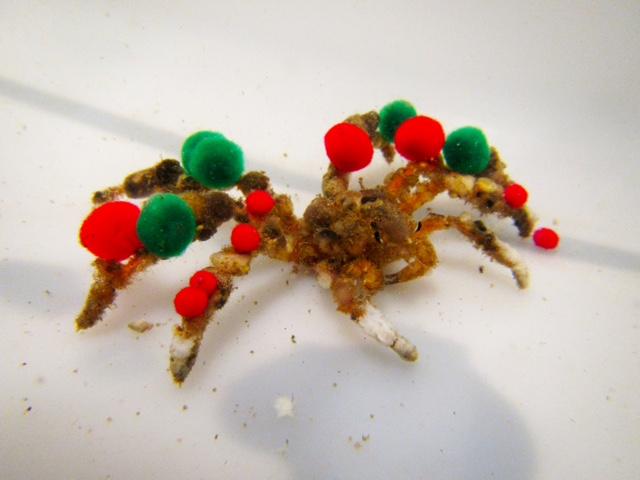
Credit: University of Delaware
'Tis the holiday season and it seems homes are festively trimmed at every turn. Ornaments of all shapes and sizes embellish everything from trees to windows and yards.
While tinsel originated in 17th century German decorating and modern day Christmas lights can be traced to the Victorian era, the idea of decorating is not an exclusively human trait.
Majoid crabs — known as decorator crabs — are well-known among marine scientists for adorning their surface with items secured from their surroundings. About 75 percent of majoid crab species are notorious for decorating with sponges, algae and other marine debris.
Scientists are uncertain what physical and environmental factors drive this decorating behavior, though it appears to be used as a means to hide from, or deter, predators.
University of Delaware marine scientist Danielle Dixson and a team of researchers that included undergraduate students studied the majoid species Camposcia retusa to identify the factors that determine patterns of, and investment in, decorating.
"The decorator crab is a perfect study example because the IndoPacific species has velcro-like substances on its shell and hooks on its appendages that enable it to secure items on its exterior," Dixson said.
The researchers ran a series of experiments with decorator crabs that were placed in individual containers and provided with craft pom-poms that had been soaked in water so they would sink to the bottom.
Half of the crabs were given a shelter for habitat to see whether having somewhere to hide affected how much or how fast the crab decorated.
Over a 24-hour period, the team photographed the crabs every hour for the first 12 hours, and at hour 24, and analyzed the images to determine where the crabs decorated, whether they rearranged things and what parts they decorated first.
Arms and legs first
In the study, all of the crabs were fully decorated within 24 hours. Most of the crabs were decorated within six hours of having access to the pom-poms. According to Dixson, this shows that decorating is an important predator adaptation because the crabs do it very quickly.
While other species of decorator crabs adorn their body first, the UD research team's study showed that Camposcia retusa decorated their appendages (arms/legs) first when a habitat was present.
This was different than other crabs that typically protect their vital organs first, but according to Dixson, still made sense because when they hide, a little bit of Camposcia retusa's arms remained outside their enclosure.
"This tells us they decorate the parts that stick out," Dixson says.
A perfect project for undergraduates
According to Dixson, this is a perfect project for undergraduates because the approach is straightforward and the students can have results in just a couple days, making it easy to add layers to the project as they go along.
It's also good way for undergrads to develop the skills to design an experiment and to refine their design based on the data collected.
For example, when no habitat was present the crabs decorated everywhere.
"The students were able to say, 'now that we know habitat matters, let's take the habitat away and see how quickly they decorate,' " Dixson said.
But just like in the holiday classic National Lampoon's Christmas Vacation, more decoration is not necessarily better. For the decorator crab, more decoration means the animal requires more energy to move around, and the slower they will be to escape predators.
Visual vs. chemical camouflage
Through ongoing research, Dixson and her students are investigating whether the crabs can actually see and choose items based on color — meaning they are visually hiding themselves — or whether their decorating habits are motivated by smell, known as chemical camouflage.
Sea sponges, for example, emit a scent that the crab may be using to chemically mask or camouflage itself from predators like eels, which have terrible eyesight but are known to hunt through smell.
They also plan to explore what could make the crabs decorate faster, such as if it could see an eel in the next tank or if the predator smell suddenly was introduced into their environment and the stakes were higher.
###
About the research team
Danielle Dixson is an assistant professor in the College of Earth, Ocean, and Environment's School of Marine Science and Policy.
Co-authors include:
Rohan Brooker, a UD post-doctoral researcher (now at University of Saskatchewan) and the paper lead author;
Enid Muñoz Ruis, an undergraduate student from University of Puerto Rico who was conducting research at UD during the study period through the college's 10-week marine sciences Research Experiences for Undergraduates (REU) program, which is funded by the National Science Foundation's Research Experience for Undergraduates (REU) program; and
Tiffany Sih, a doctoral candidate at James Cook University and ARC Centre of Excellence for Coral Reef Studies in Queensland, Australia.
The researchers published the study findings in the peer-reviewed journal Behavioral Ecology.
Media Contact
Andrea Boyle Tippett
[email protected]
302-831-1421
@UDResearch
http://www.udel.edu
Original Source
http://www.udel.edu/udaily/2017/december/crabs-decorating-behavior-predator/





